The Lazy Homesteaders: Angi’s Story
“To me, homesteading means being able to provide for ourselves without always depending on stores or pre-made things. We do this through raising our own fruits, vegetables, eggs and honey but also through being willing to learn to build or make things or maybe even deciding to do without some things. I love this motto from the Great Depression, ‘Use it up, wear it out, make do or do without.’ There is something freeing about applying that quote to our lives.” – Angi

Homesteader Profile: Angi is the author of SchneiderPeeps. She and her family live on 1 1/2 acres in Texas. Today Angi is going to share her and her family’s self-proclaimed “lazy” homesteading lifestyle.
Angi & Her Family’s Homesteading Journey
I don’t necessarily consider us homesteaders, although that seems to be what we are often called. We have gardened since the very beginning of our life together over 23 years ago and soon after that, we learned how can jelly and jam, then came the salsa. It’s just something we enjoy doing.
We bought our current property a little over three years ago and knew we wanted to do a little more than just gardening. We also wanted some fruit trees and keep chickens and bees. I guess we could be called the lazy homesteaders because we have no desire to have any other livestock. And that is okay.
When we bought our property we intentionally bought a smaller piece of land (1.5 acres) and just outside the city limits. Here’s why, we have six children and at the time our oldest son was a senior in high school and there is only an eight year difference between him and our 5th child. We are in the season of our children growing up, having dreams and leaving our home to follow their dreams. We do have a five year old also, so it will be a while before we’re empty-nesters but we’re close enough to see it. Part of being a family is making sure that we are not so focused on one person’s dream that other people cannot pursue their own dreams. When both parents have a homestead dream, sometimes the children’s dreams get overlooked. We didn’t want that happening to our family so we chose a very manageable piece of property.
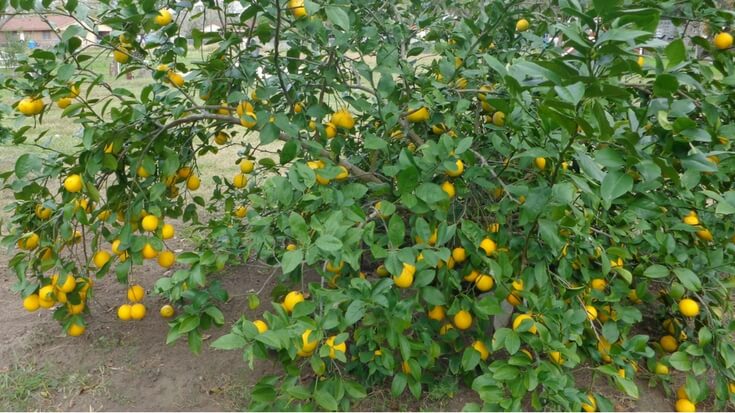
When we moved in there was one mature Meyer lemon tree and two mature pecan trees. We have since added another Meyer lemon, Satsuma, sweet orange, Key lime, grapefruit and Cara Cara orange trees. We’ve also added fig, pomegranate, apple, mulberry, peach, plum, pear, blueberry, and just this month, avocado and a polmelo tree (a type of grapefruit).
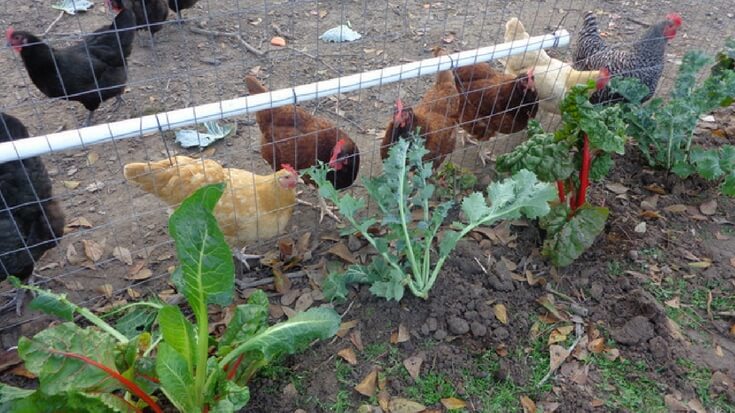
We also have a flock of about forty hens and two roosters. Two of our children are responsible for them and they sell the extra eggs to earn some spending money. The chickens are such a fun addition, although I don’t think we’ll always have so many. Our children are losing interest in them and I can see that they will not want to continue their egg business once these stop laying. But we will always have a few for eggs for our family.
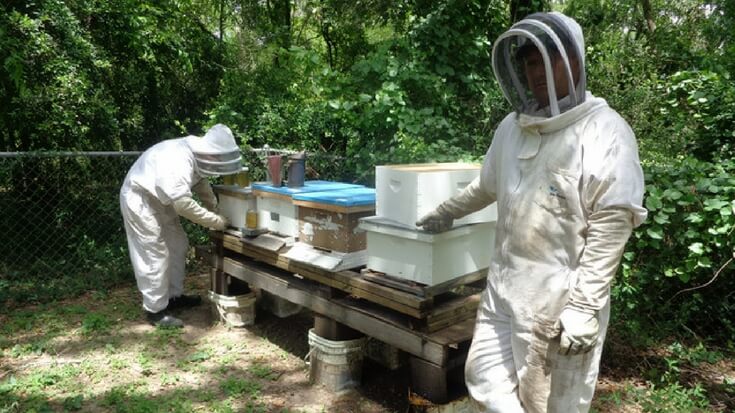
Our 17 year old son is the resident beekeeper. He also has a bee removal business. To say he is passionate about bees would be a huge understatement. The bees are fascinating and, honestly, not much work as far as the day to day care goes. They make a great addition to the lazy homesteaders’ homestead. We don’t know what he will decide to do with his bees when he goes off to college but we I *think* they’ll stay here until he has a place of his own.
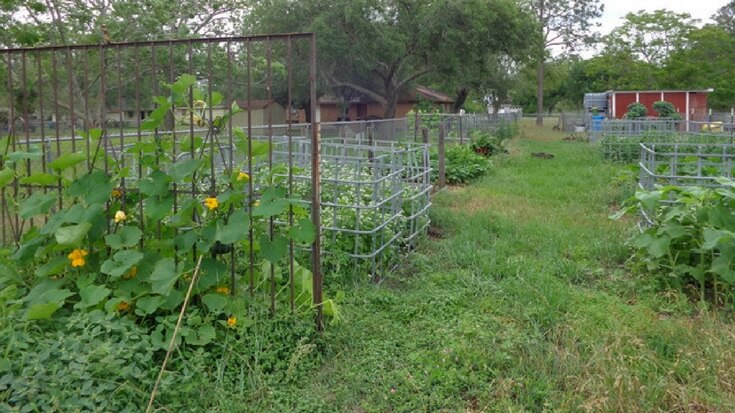
We live in a gardening zone 9 so we’re able to grow our garden year round. Some months we only have kale and swiss chard and some months we only have peppers and okra but we’re still able to harvest. We have about twenty-eight 4′ x 8′ beds plus a large area for melons, corn and overflow. We don’t use all the beds all year long, we rotate through them and let some rest each year. And I’m not the tidiest gardener in the world. I try, but sometimes things just don’t go according to plan.
Because of our large garden we eat very seasonally and I don’t feel a need to do a ton of preserving. If it’s growing in our garden, we’re eating it. This means in the summer we have lots of green beans, zucchini and yellow squash and in the winter we eat a lot of greens, broccoli and cauliflower. Just about the time we think we can’t stand another meal with kale as a side, the first squash is ready. And what a treat that squash is after 6 months of not having it.
At this point we buy our dairy and meat from local farmers, we’re hoping that in the future we’ll have enough produce (especially fruit) to be able to trade for some of the things we don’t raise. Homesteading doesn’t have to be all or nothing. It’s okay to pick and chose the aspects of homesteading that inspire you and just focus on those things.
Be sure to follow Angi on her homesteading journey by visiting her website, SchneiderPeeps.
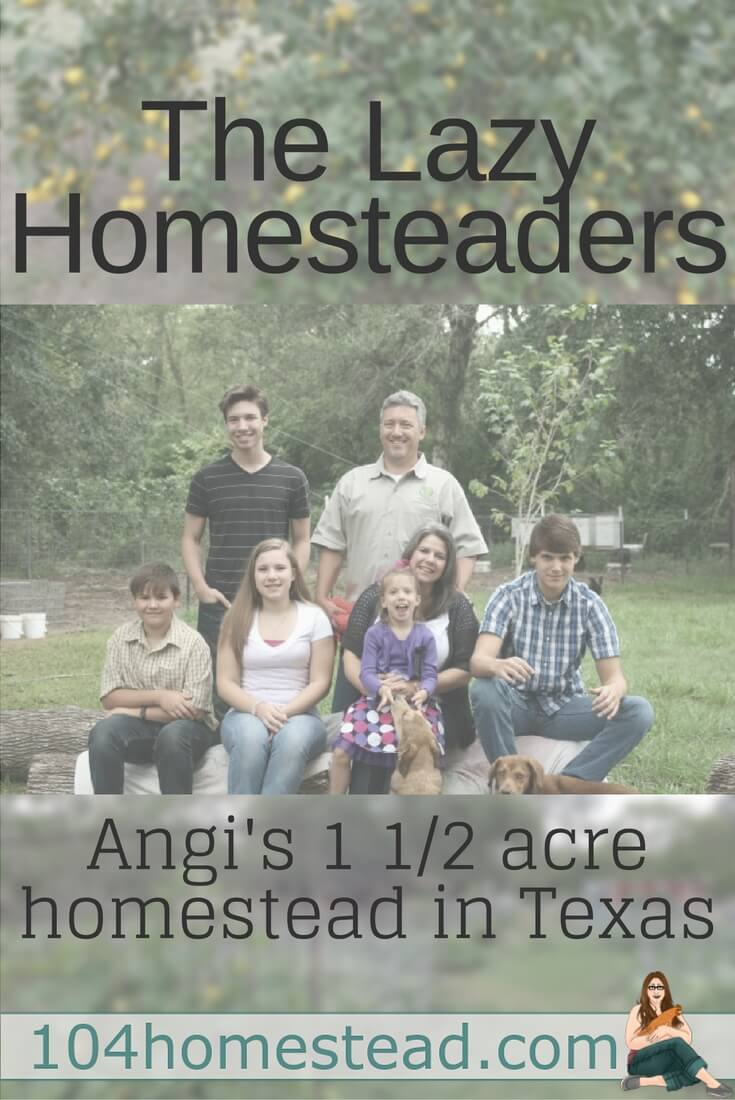

Hello. I grew up on our family farm. I really don’t understand the homesteaders of today. We always had a garden, raised rabbits, chickens, calves and pigs. We canned, we blanched, we froze, and we pickled. We still do some of these things. We never had a name for it so what we always did has a name. Very interesting to see folks going back to the tried and tested ways.
I also live in a zone 9 climate, here we’ve been having a problem with citrus rats. They’re different than regular rats and common rat traps and baits don’t work. We’re on the verge of uprooting all fruit bearing trees from the property. Just wondering, if you, having so many fruit trees have the same issues and if so, what you do to rid the problem?
Hi Tammy, we don’t have citrus rats and after doing a bit of research I’m feeling for you. I did find this article from the University of Florida (http://edis.ifas.ufl.edu/uw120) that talks about using a variety of methods to control the rats. They suggest things like keeping trees pruned and off fences, using trunk wraps, live traps and even snakes to control the rats. I’m sorry I couldn’t be more helpful.
Rats love Coke, Coca Cola. However, the acidity of Coke kills the rats. Try a water bottle at night only with fresh Cola each night. Remove during the day so you don’t attract ants, ect. Worth a try. Won’t poison other pets or children.
Rats love Coke, Coca Cola. Each night put out Coke, use a bottle that hangs upside down for the rats to drink. The Coke acidity destroys their innards. I would remove the bottle during daytime so you don’t attract ants, etc…
Thank you for sharing your story; it’s very inspirational. My husband and I have been gardening for many years and recently added chickens. We’d love to raise bees, too, but our lot doesn’t quite meet the city regulations so that will have to wait.. In addition to our soil garden we also have an aquaponics system that has been very successful, for veggies and tilapia. We have dreams of owning some acreage for our little homestead, but for now we’re making the best of our 1/4 acre urban lot. Like you, we also have children in school and want to wait until they are older before relocating to a more rural area. We live in the DFW area of Texas and would love to know what part of the state you call home. Thanks again for sharing your family’s story!
Hi Loretta, I’m so sorry for my much delayed response. We live along the the Gulf Coast between Houston and Corpus Christi. We spent six years in Ft. Worth while my husband went to Southwestern Theological Baptist Seminary, we loved living there.
Jess, Thanks for another wonderful article. Angi is one of my most favorite people on the planet! I enjoyed reading her story so very much. My favorite quote is “Homesteading doesn’t have to be all or nothing. It’s okay to pick and chose the aspects of homesteading that inspire you and just focus on those things. ” She just has a way of simplifying things. You inspire me to think of others with these great articles 🙂
Thanks for the sweet words, Rhonda. That means a lot coming from a real farmer ;-).
I totally agree. Even on my 10 acres I couldn’t do it all. There’s the cost, and then there was just me and my boy. I do what I can, support other homesteaders when I can, and always make do.
Thanks for sharing that, Robyn. There is so much more to consider than just space – time, hands available and other passions need to be considered also.
I love that you were so intentional about the aspects of homesteading you chose to put your energy into. Because of that, they add value to your current stage of life without being overwhelming. I’ve found that I’m a more successful homesteader because I don’t try to do it all. I’m so glad to have it confirmed that less can be more 🙂
Absolutely Amy. It’s more important to do a few things well that to try to do everything.
I love the tomato cages, I hadn’t thought of using those as tomato cages. We just got a bunch from a neighbor, now I can put them to good use.
Thanks! They work really great, we use strips of old t-shirts to tie the tomatoes when we need to. They are also good for luffa.